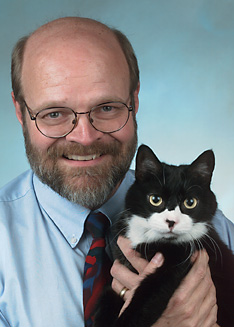At Cornell Feline Health Center, new cat book author's muse is Dr. Mew
By Roger Segelken

If the new book from the director of Cornell University's Feline Health Center reads like "What Your Cat Wants You to Know about Kitty Care," that's not surprising.
Author and veterinarian James R. Richards had lots of inspirational help with his ASPCA Complete Guide to Cats (Chronicle Books, ISBN 0-8118-1929-9) from one of the best-cared-for cats in the country: his purring office mate, Dr. Mew.
"You'd be surprised what a cat in the lap, yearning to be scratched, does for writer's block," says Richards. "I couldn't have done it without him," the author says about the book, which is subtitled "Everything You Need to Know About Choosing and Caring for Your Pet."
Lacking the D.V.M. degree of the author-of-record, the muse-like Mew keeps a low but wide-tracked profile in Cornell's College of Veterinary Medicine. The black-and-white domestic shorthair (a fancy name for non-purebred cats, which make up about 95 percent of America's feline population, according to the book) seldom ventures from the Feline Health Center offices.
To stray from the center -- the college's research and education unit for cat owners and veterinarians who care for feline patients -- would risk capture and rebuke, Dr. Mew seems to know. Pets of any kind are strictly forbidden in college buildings, but the wily Dr. Mew has slipped through a regulatory loophole.
"We managed to get him classified as an educational exhibit," Richards says, as Dr. Mew rubs a display rack of center-published educational brochures with titles like "Gastrointestinal Parasites of Cats" and "Inflammatory Bowel Disease."
Such medical topics are addressed in the new book, although without quite as much technical detail as in another publication from the veterinary college, The Cornell Book of Cats (Villard Books, ISBN 0679449531). "I've tried to make this book accessible and user-friendly for the majority of cat owners and would-be cat people," Richards says, noting that the guide begins with the frank discussion, "Are You Ready for a Cat?"
Readers who decide they are cat-ready -- but can't decide which breed to choose -- learn the advantages of domestic shorthairs, such as healthfulness ("a broad genetic background that makes hereditary problems relatively unlikely") and price ("usually inexpensive, or even free") as well as the attributes and disadvantages of the other 5 percent of cats, the purebreds. In fully illustrated coverage of 50 breeds, ranging alphabetically from Abyssinian to York Chocolate, the author notes which are good with children, talkative, high-energy lap cats, or which have special grooming needs. The leopard-like Bengals, for example, are high-energy animals that will "find their own toys" if none are provided but also are prone to a breed-related eye condition called entropion, which might require corrective surgery, according to the author.
Other sections cover "What Makes a Cat a Cat?" with reviews of feline anatomy, heart and lungs, digestive and urinary systems, reproduction, skin and coat, and the senses, including an explanation for a bizarre cat expression the so-called flehmen response, that puzzles many owners. When a cat lifts its head, wrinkles its nose and partially opens the mouth while curling the lips, the authors observes, the animal is trying to smell another cat through the vomeronasal organ, the pouchlike structure in the roof of the mouth.
Also covered are everyday care of the cat, including feeding, grooming, playing, solving behavior problems and traveling, as well as cat health concerns, such as viral diseases, urinary tract disorders and cancer, and feline first aid. Yes, it is possible to give mouth-to-nostril resuscitation to a cat that isn't breathing, Richards says, and he gives step-by-step, not-to-panic directions for the lifesaving maneuver.
As a cat's life approaches a natural end, advice is given on the special needs of the geriatric feline. Human psychological needs are not ignored, either, with a list of quality-of-life considerations when euthanasia is the humane resolution for a cat's terminal illness. Helped to cope with the loss of a beloved cat, readers are advised on the next question: when -- if at all -- to adopt again? "Do whatever feels right to you and your family," Richards counsels. "A new cat will bring laughter and companionship into your home. When you are ready, there is a cat waiting to share his life with you."
"I like these critters, I truly do," veterinarian Richards says. "I hope my high regard for kitties comes through in the book. It's really a celebration of cats."
Meanwhile, Dr. Mew is celebrating lunchtime. Like too many American cats, the rotund feline is battling a weight problem. The reasons to avoid obesity, such as an increased likelihood of feline diabetes, and the solutions are right there in the ASPCA Complete Guide to Cats (pages 234-239), almost as if muse Mew had inspired them.
Media Contact
Get Cornell news delivered right to your inbox.
Subscribe